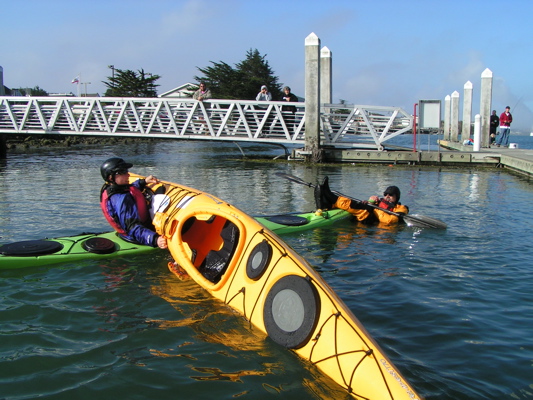There’s no doubt that cold water represents the most relevant, dangerous, and underappreciated of the objective hazards faced by the average sea kayaker. Immersion in cold water (<60F) will quickly incapacitate you and put you at risk for the development of hypothermia; a life-threatening condition where the body systematically shuts down in response a drop in core temperature. The best way to protect yourself against hypothermia is to prevent it from happening by being aware of the dangers of cold water, dressing appropriately for the environment, and knowing what to do if you find yourself in the frosty drink. This post will cover the third and final link in this chain of survival.
Note: This article assumes that the reader is aware of the dangers of cold water and is dressed appropriately for paddling on cold water. Please read the following posts for a refresher on these topics:
Cold water immersion and survival
How to dress appropriately for cold water paddling
Step 1: Get out of the Water!
Obviously, the first thing that you should do if you find yourself in the frosty drink is to remove yourself from the water as quickly and efficiently as possible! The fact that you’re dressed for immersion (in a wetsuit or drysuit) will buy you a little extra time but will not keep you “safe” forever. It’s important that you try to remain calm and act in a calculated way in order to ensure that your first attempt at re-entry is successful. If you’re alone (not recommended) then you should attempt to re-enter your kayak via the technique that you are most comfortable and practiced with. The paddle float re-entry is a good choice for its stability but remember that it can take a few minutes to set things up. Using a solid foam paddle float can help to accelerate this rescue in cold water.

Partner rescues such as the X-rescue are faster and more efficient in cold water. Note that the swimmer may lie on the front deck of the rescuers’ kayak to get further out of the water without compromising stability. (Image by Kayakzak.com)
If you’re paddling with a partner then you have more options and will be able to get out of the water faster with their help. The so-called “X-Rescue” is one of the better cold water re-entries. In this technique, the swimmer climbs onto the front deck of the rescuer’s kayak. The capsized kayak is then pulled across the rescuers deck by both the swimmer and the rescuer in order to drain the water. This “X” system is remarkably stable provided that the conditions are reasonable and the “swimmer” maintains a low profile. Finally, the swimmer is able to reenter their kayak while the rescuer stabilizes the platform. The main cold-water benefit of the “X-Rescue” is that the swimmer is removed from the water very quickly thus minimizing their exposure.
***Remember that the key to this stage is to get out of the water as quickly and efficiently as possible. This may require that you diverge from “proper” re-entry technique and take a “whatever works” approach to physically remove your body from the water.
Step2: Remove wet clothing
Just because you’re back out of the cold water doesn’t mean that you’re out of trouble! Wet clothing is a major liability as it will continue to draw heat away from your body. Therefore, it’s critical that you remove any wet clothing and change into the spare layers that you remembered to bring along in your dry bag. If you’re reasonably close to a favorable landing (say within 5-10min) then it’s a good idea to head to shore to change and warm up. However, if you’re a ways out then don’t wait to change out of those wet clothes. Have the group raft up to help stabilize your kayak while you change into something dry.

Clearly, this couple is caught up in the moment…but they should consider changing out of those wet cloths post haste in order to prevent hypothermia!
Step 3: Treat for hypothermia if necessary
Developing some level of hypothermia is a very real and serious consequence of cold water immersion. A capsized paddler may become hypothermic if the rescue takes too long, if they remain in wet clothing for too long, or (in some circumstances) even if they were able to recover quickly. It is the responsibility of the other group members to evaluate and monitor the capsized paddler for signs of hypothermia once they are back in their kayak. The first visible signs of hypothermia include:
- Shivering
- Confusion
- Lack of coordination
Don’t hesitate to act on these signs! Promptly bring the group to shore and attend to the needs of the recently capsized paddler. The goal of the treatment is to prevent additional heat loss and help the victim warm back up. You should have everything that you need to accomplish this in your groups’ emergency supplies. Some backcountry treatment strategies include:
- Removing any remaining wet clothing from the victim and replace it with dry clothing
- Have the victim get into a sleeping bag or wrap them with additional layers
- Insulate the victim from the group with a mattress pad or other insulation
- Share heat by getting into the sleeping bag with the victim. (Keep your dry clothes on so that you don’t become hypothermic too!)
- Provide a warm drink to the victim if they are alert and able to swallow.
- Light a fire and try to reflect some heat toward the victim. Make sure that they’re not too close to the fire as extreme heat may do them more harm than good.
- Warm up some water bottles (warm not boiling!), place them in a large wool sock, and give them to the victim to hold in the sleeping bag.
Most of the time, these simple measures will be enough to help the victim recover from their mild hypothermia in the field. However, if the victim fails to recover despite your best rewarming efforts, their symptoms get worse, or they lose consciousness then you’re dealing with a more serious form of hypothermia. This is a true medical emergency and the best course of action is to get on your marine radio (Channel 16) and call for help while you continue your rewarming efforts.
Things not to do if you capsize in cold water:
- Never attempt to swim to shore if you capsize in cold water. Swimming in the cold water will only sap your energy more quickly and accelerate the development of hypothermia. You always have a better chance of survival by staying with your kayak and attempting re-entry.
- Avoid paddling alone on cold water. Your survival post-cold water immersion may depend on the help of a paddling partner to assist in your capsize recovery and recognize the early signs of hypothermia. Paddling alone puts you at a distinct disadvantage.
- Never hesitate to initiate treatment for hypothermia. If you recognize the early signs of hypothermia in yourself or your paddling partner then it is time to get off the water and deal with the situation before it has the chance to get out of control.
Paddling during cold water months can be an incredible experience. The waters are quiet, the scenery is magical, and there’s a sense that you’ve ventured into an unknown place. Just remember that cold water is no joke; it can be very dangerous especially if you’re not prepared. If you respect the dangers of cold water, dress for immersion, and know what to do if you capsize then your cold water paddling trips will be safer and more enjoyable!
Happy and Safe Paddling!
-Kayak Dave



